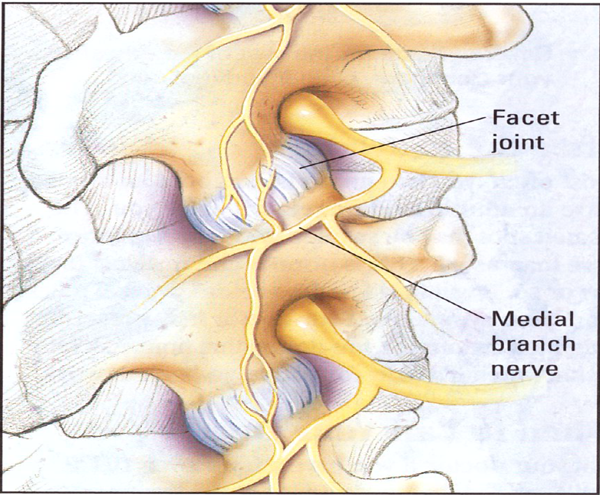MEDICAL BRANCH BLOCK
Causes, Recovery, and Considerations
What is a Medical Branch Block?
A medial branch block refers to a treatment for pain that may have developed due to a damaged or inflamed facet joint in the spine. A facet joint refers to a bony structure that connects spinal vertebrae together. Facet joints aid in controlling the movement of the spine and provide additional support and stability for the vertebrae. Clinical research has shown that facet joint pain stands as the leading cause of approximately 45% of all neck and back pain reported by patients.
Although facet joint problems occur as the usual cause of neck and back pain, chronic pain may also result from trauma or an injury. Another common condition that may affect the facet joints includes arthritis. This condition develops when the cartilage that protects the joints starts to deteriorate or the synovial fluid that cushions these joints starts to decrease.
Arthritis often occurs with age, but may also develop due to an autoimmune disease. Facet joint arthritis, specifically, may contribute to the source of spinal irritation and back pain. Scoliosis, which refers to the abnormal curvature of the spine, and poor posture, may also cause chronic back pain.
Medical Branch Block Procedure
Healthcare professionals usually recommend steroid injections, which denote a form of pain management treatment for certain conditions. The injections involve the administration of an anesthetic (such as lidocaine, bupivacaine, or mepivacaine) as well as steroids (dexamethasone, for example) directly into the targeted region of the location of the facet joints.
The injections usually provide the patient with long-lasting pain relief. However, doctors also use these anesthetics as a diagnostic tool to determine if the medial branch block will prove effective. If two steroid injections produce dramatic pain relief, a physician usually recommends the block procedure next. After applying the local skin anesthetic, the physician uses fluoroscopy (x-ray) guidance to place a needle along the nerves that supply the inflamed joint.
The effects of a medial branch block generally last much longer than a steroid injection. This procedure targets the nerves that send sensory information to the facet joints (such as the medial branch nerves). In order to block these nerve signals, the specialist inserts a needle into the area of the affected nerves and then administers substances that destroy nerve tissue. This causes the semi-permanent disruption of pain signal transmission and the significant relief of facet joint pain. Medical reports have shown that medial branch blocks prove safe and effective for neck and back pain.
This procedure also carries non-invasive benefits as it helps patients avoid having to undergo surgery.
Risk and Cautions
Risks associated with a medial branch block generally relates to problems with the needle placement or other technical errors. For instance, a small number of block procedures (approximately 3%) performed in the upper back or neck led to the accidental injection of the medication into a blood vessel and not the desired nerve.
The injected anesthetic may also result in the gradual desensitization of healthy nerves and may also cause unwanted interactions with medication taken by the patient. In rare cases, the injected anesthetic may cause nausea, vomiting, chest discomfort, and temporary neurological problems. This has only occurred in approximately 2% of patients who have received medial branch blocks. Due to the possible occurrence of such complications, physicians conduct necessary medical examinations before deciding if a patient a patient may proceed as a good candidate for medial branch block or not.
Results
Physicians have performed medial branch blocks safely for many years with excellent outcomes. The benefit from this procedure typically occurs several minutes following the procedure. As per the physician’s request, the patient records pain levels during the first days of the procedure to ensure accurate diagnosis of the facet joints as the pain source.
Believe you have have may need a Medical Branch Block?


